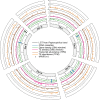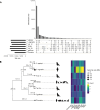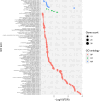Comparative genomics of the parasite Trichomonas vaginalis reveals genes involved in spillover from birds to humans
- PMID: 40707449
- PMCID: PMC12289875
- DOI: 10.1038/s41467-025-61483-w
Comparative genomics of the parasite Trichomonas vaginalis reveals genes involved in spillover from birds to humans
Abstract
Trichomonas vaginalis, the causative agent of the venereal disease trichomoniasis, infects men and women globally and is associated with serious outcomes during pregnancy, increased risk of HIV-1 infection, and cancers of the human reproductive tract. Species of trichomonad parasitize a range of hosts in addition to humans, including birds, livestock, and pets. Genetic analysis of trichomonads recovered from columbid birds has provided evidence that they undergo frequent host-switching, and that a spillover event from columbids likely gave rise to T. vaginalis in humans. Here we describe a comparative genomics study of seven trichomonad species, generating chromosome-scale reference genomes for T. vaginalis and its avian sister species Trichomonas stableri, and assemblies of five other species that infect birds and mammals. Human-infecting trichomonad lineages have undergone recent and convergent genome size expansions compared to their avian sister species, a result of extensive repeat expansions specifically of multicopy gene families and transposable elements, with genetic drift likely a driver due to relaxed selection. Trichomonads are thought to have independently host-switched twice from birds to mammals/humans. We identify gene functions implicated in the transition, including host tissue adherence and phagocytosis, extracellular vesicle formation, and CAZyme virulence factors, which are all associated with pathogenesis phenotypes.
© 2025. The Author(s).
Conflict of interest statement
Competing interests: I.L. and H.M. are employees of Phase Genomics, a company that provides Hi-C services and products. The following author wishes to disclose his industry relations although there are no competing interests to the work published here: R.A.B. is an employee of Genentech/Roche. The remaining authors declare no competing interests.
Figures






Update of
-
Comparative genomics of the sexually transmitted parasite Trichomonas vaginalis reveals relaxed and convergent evolution and genes involved in spillover from birds to humans.bioRxiv [Preprint]. 2024 Dec 23:2024.12.22.629724. doi: 10.1101/2024.12.22.629724. bioRxiv. 2024. Update in: Nat Commun. 2025 Jul 24;16(1):6487. doi: 10.1038/s41467-025-61483-w. PMID: 39763951 Free PMC article. Updated. Preprint.
References
-
- Stabler, R. M. Trichomonas gallinae: a review. Exp. Parasitol.3, 368–402 (1954). - PubMed
Publication types
MeSH terms
Grants and funding
- R21 AI149449/AI/NIAID NIH HHS/United States
- R21AI149449/U.S. Department of Health & Human Services | NIH | National Institute of Allergy and Infectious Diseases (NIAID)
- U24AI183870/U.S. Department of Health & Human Services | NIH | National Institute of Allergy and Infectious Diseases (NIAID)
- CMRPD1M0571-2/Chang Gung Memorial Hospital, Linkou (Linkou Chang Gung Memorial Hospital)
- U24 AI183870/AI/NIAID NIH HHS/United States
LinkOut - more resources
Full Text Sources

